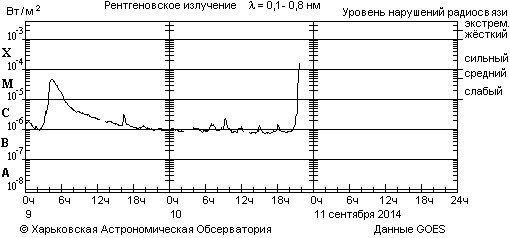Two strong solar flares launched off the sun on September 9 and 10. Many media declared that Northern Lights would be seen in Russia and Kazan, in particular. However, Professor Ilfan Bikmaev, Acting Head of the KFU Department of Astronomy and Satellite Geodesy, promises no spectacular space shows.
- This week we witness the burst of solar activity. Two strong solar flares launched off the sun on Tuesday and Wednesday, said Ilfan Bikmaev. Orbital solar observatories are constantly registering X-ray fluxes. Pic.1 shows the graph of behavior of the sun X-ray flux for the last few days, taken by the X-ray monitor of space solar telescope.

Pic. 1. The graph of behavior of the sun X-ray flux showing two strong flares on September 9 and 10, 2014
Terrestrial optical observatories in many countries spy the sun surface with special solar telescopes and instruments in order to define the position, size and configuration of sunspots, its burst intensity and polarization. The received data is sent to international centres. Some observatories use their own data and open information of international centres to organize a solar activity service.
Thus, in Russia there are several services like this - in Pulkovo Observatory of the Russian Academy of Sciences (RAS) (St.Petersburg), Crimea Astrophysical Observatory, Special Astrophysical Observatory in Northern Caucases where the biggest world telescope RATAN-600 is used.

- The today's clear weather in Kazan allowed taking a photo of the sun surface with a small solar telescope of the KFU Planetarium in Engelgardt Astronomical Observatory.
 Pic. 2. Digital photo of the sun surface taken on September 11, 2014 by a solar scope of KFU Planetarium.
Pic. 2. Digital photo of the sun surface taken on September 11, 2014 by a solar scope of KFU Planetarium.
The picture well demonstrate sunspots near the solar disc centre, these are the very spots that induced this week's flares. Intense flares like the one that erupted Wednesday produce coronal mass ejections, or "CME"s. A coronal mass ejection contains billions of tons of energetic hydrogen and helium ions as well as protons and electrons ejected from the sun's surface. It can impact high-frequency radio communication and other communication devices. Solar flares can also knock out man-made satellites and power grids, and affect navigation equipment on airplanes.
A 1989 geomagnetic storm knocked out the Hydro-Québec power grid and left millions of people without electricity for up to nine hours.